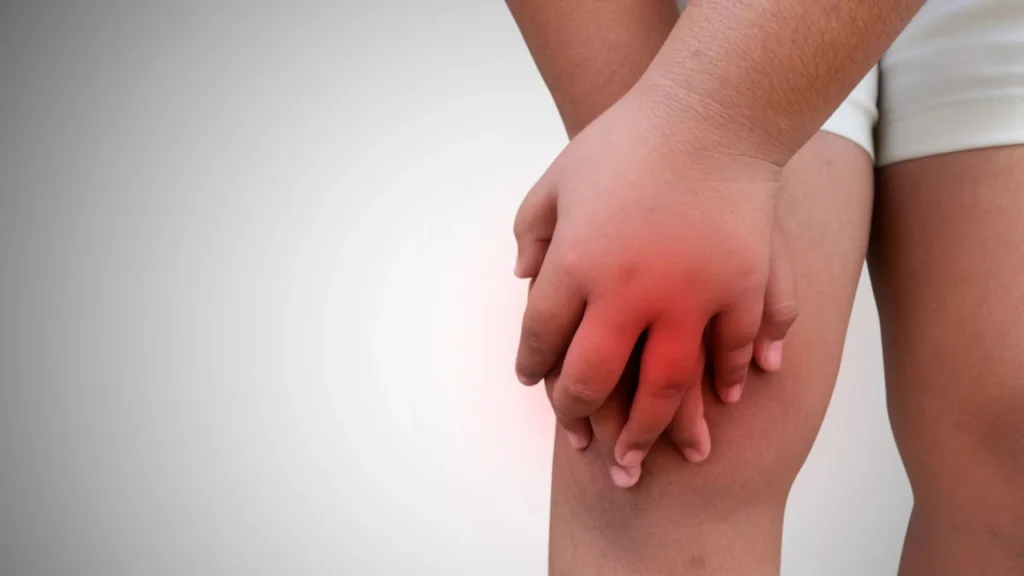






You might expect that arthritis is something that only happens to older adults, but it can actually affect people of all ages, including children. Nearly 300,000 kids and teens in the United States have some form of arthritis, and nearly one child in every 1,000 worldwide. With treatment, most children achieve periods with no symptoms, and sometimes the disease goes away permanently with no further need for medications. Continue reading to learn more about arthritis can affect kids and how parents can help their children manage the condition.
In general, the term arthritis is used to describe pain, swelling, and stiffness in the joints. In adults, this is usually due to wear and tear after years of sports or chronic repetitive motions. In contrast, most cases of juvenile arthritis are due to a malfunctioning immune system. Normally, the immune system can tell the difference between the body’s own cells and invaders like germs and viruses. Childhood arthritis develops when the immune system gets confused and attacks the healthy cells in the joints, resulting in painful inflammation. This is officially known as juvenile idiopathic arthritis but it was once called juvenile rheumatoid arthritis. Doctors do not know exactly why juvenile arthritis happens but girls and children who were exposed to cigarette smoke during pregnancy are at slightly higher risk.
Arthritis affects each child differently but the most common symptoms are joint pain, swelling, warmth, and stiffness that are typically worse in the morning and after a nap or prolonged sitting.
The symptoms can be unpredictable and range from mild to severe–some kids may only have a few periods of active disease while others experience persistent symptoms. Childhood arthritis can also affect more than just the joints depending on the activity of the immune system. Other signs to watch for include:
Healthy lifestyle habits and home remedies can help ease symptoms and relieve pain for anyone struggling with arthritis (and are most often recommended). For instance, low-impact exercises like swimming, biking and yoga are good for muscle strength and joint flexibility. Balancing physical activity with rest is also essential, especially during periods of active inflammation. Taking breaks throughout the day preserves energy and helps protect the child’s joints.
A heating pad or warm bath is best for soothing stiff joints and relaxing tired muscles, especially in the morning. Just keep in mind that heating pads should be set to “warm” rather than “hot” temperatures to prevent burning the skin. Alternatively, contoured gel cold packs are ideal for inflamed joints to reduce swelling, numb the area and reduce sensitivity to pain. The non-toxic gel remains flexible as it freezes and the fabric cover protects the skin from frostbite. Cold and heat can be used intermittently throughout the day as long as they are not left in place for more than 20 minutes. Some people even find it helpful to alternate between the two temperatures to simultaneously reduce pain and inflammation, stimulate circulation and loosen tight muscles.
While there is no cure for childhood arthritis, treatments and medications are available to slow down or stop inflammation and preserve joint function. Doctors may prescribe non-steroidal anti-inflammatory medicines (NSAIDS) like ibuprofen and naproxen to help reduce pain and swelling, but it depends on patients’ medical conditions. Unfortunately, inflammatories do not stop the immune system’s attack on the joints so immunosuppressant medicines like etanercept (Enbrel) or adalimumab (Humira) may be needed. Always consult with your doctor for more information on which treatment options are best for you.
Arthritis can happen to adults and children alike, and growing up with arthritis can be challenging. However, with treatment, most children with arthritis are able to live full, active lives and keep up with their peers. HomeCare Hospital Beds has at-home therapy options for those who would like to use heat and cold to relieve their pain and discomfort. Parents should always check with their child’s healthcare providers first before trying either hot or cold therapy.
References
American College of Rheumatology. (2022). Juvenile arthritis. Retrieved from https://www.rheumatology.org/I-Am-A/Patient-Caregiver/Diseases-Conditions/Juvenile-Arthritis
Arthritis Foundation. Juvenile arthritis. Retrieved from https://www.arthritis.org/diseases/juvenile-arthritis
Centers for Disease Control and Prevention. (2020). Childhood arthritis. Retrieved from https://www.cdc.gov/arthritis/basics/childhood.htm
Harvard Health. (2022). Foods that fight inflammation. Retrieved from https://www.health.harvard.edu/staying-healthy/foods-that-fight-inflammation
Mayo Clinic. (2020). Juvenile idiopathic arthritis. Retrieved from
National Institutes of Health. (2021). Juvenile idiopathic arthritis (JIA). Retrieved from https://www.niams.nih.gov/health-topics/juvenile-arthritis




| Cookie | Duration | Description |
|---|---|---|
| cookielawinfo-checkbox-analytics | 11 months | This cookie is set by GDPR Cookie Consent plugin. The cookie is used to store the user consent for the cookies in the category "Analytics". |
| cookielawinfo-checkbox-functional | 11 months | The cookie is set by GDPR cookie consent to record the user consent for the cookies in the category "Functional". |
| cookielawinfo-checkbox-necessary | 11 months | This cookie is set by GDPR Cookie Consent plugin. The cookies is used to store the user consent for the cookies in the category "Necessary". |
| cookielawinfo-checkbox-others | 11 months | This cookie is set by GDPR Cookie Consent plugin. The cookie is used to store the user consent for the cookies in the category "Other. |
| cookielawinfo-checkbox-performance | 11 months | This cookie is set by GDPR Cookie Consent plugin. The cookie is used to store the user consent for the cookies in the category "Performance". |
| viewed_cookie_policy | 11 months | The cookie is set by the GDPR Cookie Consent plugin and is used to store whether or not user has consented to the use of cookies. It does not store any personal data. |